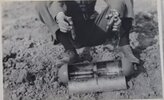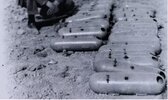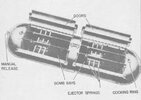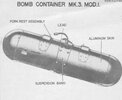Can someone throw light on this undocumented RAF bomb container from the early 1930s?
It is notably different from the regular Baby incendiary bomb conatiner of the early 1920s (which was still in use in other countries such as Spain till the late 1930s).
It shows similtudes witf the Mk3 bomb conatiner for Anti-Aircraft bombs developped by the US Navy in the mid 1930s, and may well have been the inspiration for it.
(British influence on bombs development was very strong in the USN, most of the bombs used by the USN till the introduction of the US made cylindrical bombs in the early 1930s being in fact copies of British bombs).
The UK National Archives in Kew show indication of quite an activity of development of such bomb conatyiners all along the twenties and the thirties - this will culminate in teh development of the various SBC in the late thirties:
Baby incendiary bomb containers 20lb 1926 AVIA 18/194
New type containers for baby smoke bombs 1928 AVIA 18/250
Comparative trials with standard and series type containers for baby smoke bombs 1928 AVIA 18/264
Containers for anti-personnel fragmentation bombs 1928 AVIA 18/252
Containers for small type anti-personnel fragmentation bombs 1928 AVIA 18/237
Containers for 1½" smoke or incendiary bombs 1929 AVIA 18/302
Baby incendiary bomb containers for use with glass bombs 1929 AVIA 18/283
Baby incendiary bomb container adapter for universal bomb carrier 1931-1932 AVIA 18/345
Containers for 4½lb high explosive bombs 1931 AVIA 18/343
Smoke bombs 5oz: distribution from 20lb and 112lb containers 1931 AVIA 18/347
Container for 5oz. bombs 1932 AVIA 18/360
Container 112lb type for incendiary bombs 1932 AVIA 18/363
Baby incendiary bomb container: installation on 112lb. S.T. and universal carriers 1935-1936 AVIA 18/437
Sadly none of these documents is online.


for copmparison - the USN Mk3 bomb container. Differences can eb seen, most notably the "door" system:


It is notably different from the regular Baby incendiary bomb conatiner of the early 1920s (which was still in use in other countries such as Spain till the late 1930s).
It shows similtudes witf the Mk3 bomb conatiner for Anti-Aircraft bombs developped by the US Navy in the mid 1930s, and may well have been the inspiration for it.
(British influence on bombs development was very strong in the USN, most of the bombs used by the USN till the introduction of the US made cylindrical bombs in the early 1930s being in fact copies of British bombs).
The UK National Archives in Kew show indication of quite an activity of development of such bomb conatyiners all along the twenties and the thirties - this will culminate in teh development of the various SBC in the late thirties:
Baby incendiary bomb containers 20lb 1926 AVIA 18/194
New type containers for baby smoke bombs 1928 AVIA 18/250
Comparative trials with standard and series type containers for baby smoke bombs 1928 AVIA 18/264
Containers for anti-personnel fragmentation bombs 1928 AVIA 18/252
Containers for small type anti-personnel fragmentation bombs 1928 AVIA 18/237
Containers for 1½" smoke or incendiary bombs 1929 AVIA 18/302
Baby incendiary bomb containers for use with glass bombs 1929 AVIA 18/283
Baby incendiary bomb container adapter for universal bomb carrier 1931-1932 AVIA 18/345
Containers for 4½lb high explosive bombs 1931 AVIA 18/343
Smoke bombs 5oz: distribution from 20lb and 112lb containers 1931 AVIA 18/347
Container for 5oz. bombs 1932 AVIA 18/360
Container 112lb type for incendiary bombs 1932 AVIA 18/363
Baby incendiary bomb container: installation on 112lb. S.T. and universal carriers 1935-1936 AVIA 18/437
Sadly none of these documents is online.


for copmparison - the USN Mk3 bomb container. Differences can eb seen, most notably the "door" system:


Last edited:
